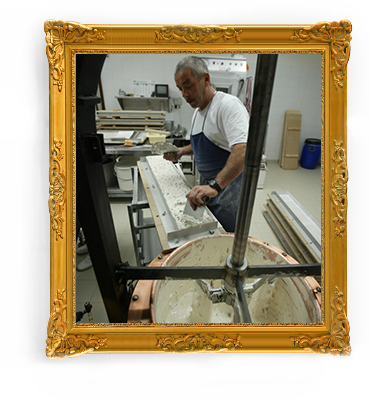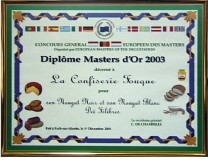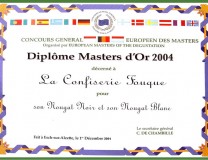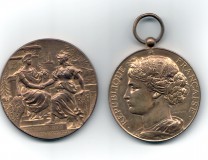Our white and black Nougats
White, soft or firm, the recipe for the white nougat is ancient and hasn’t changed using: honey, sweet almonds or pistachios. But all types of honey and almonds don’t always suit. For honey, some flowerings give an acrid taste after being cooked. For this reason we select beekeepers who insure that their bees don’t have access to chestnut trees for example.
The white nougat is soft and unctuous whereas the black nougat is caramel like. The main difference between white and black nougat comes from the cooking method
The black nougat is made by simply mixing honey and almonds. This nougat is cooked on an active flame mixing energetically until the honey become like caramel and the almonds are done (around 45 minutes). The almonds cooking in honey make a characteristic noise; an expression says that “the almonds sing”. This step is critical for the taste of the nougat as even a few seconds of overcooking and the nougat will have a burned flavor. The nougat is then poured into big molds coated with unleavened paper and left for several hours before being cut in bars and wrapped in paper.
An amusing anecdote suggests cooking the black nougat before sunrise to avoid the kitchens being infested by bees.
Indeed, at the beginning of the nougat season the bees, stocking their last honey before winter and smelling honey cooking, think that their stock is burning. These hard working and courageous bees then come quickly to save their honey using the orientation of the sun to locate the kitchens. To avoid such invasion the only solution is to cook the nougat before sunrise, the bees still being at their beehive.
The white nougat is a mix of honey and egg-white whipped until stiff and cooked on a “bain-marie” slowly mixing for 5 hours. When the mix is white and its volume has doubled like a “soufflé”, cooked sugar is added to stabilize, thus avoids using preservatives and chemicals. The last ingredients are then added to the mixture: baked almonds for the white nougat “Provence” or pistachios for the white nougat “Félibres”, and the nougat is ready to be poured and coated with unleavened paper.
Hours after the pouring the nougat is cut into bars but not yet wrapped. In contrary to the black nougat, the white nougat has to be flipped over in their molds and left for one more night until the nougat has reached maturity. It’s only then that the nougat is wrapped in a protective paper. Note that the size of the mold will depend on the size of the different nougat bars
Médails and Certificates
1st prize at the Master Européen de Dégustation 2004 for
|
1st prize at the Master Européen de Dégustation 2003 for our Black & White nougat. |
|---|---|
1st prize at the Master Européen de Dégustation 2002 for our Black & White nougat. |
|
Gold Medals & Certificate won in November 1897.These are the oldest still in our possesion |
|











